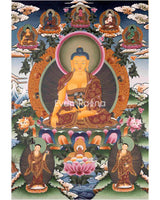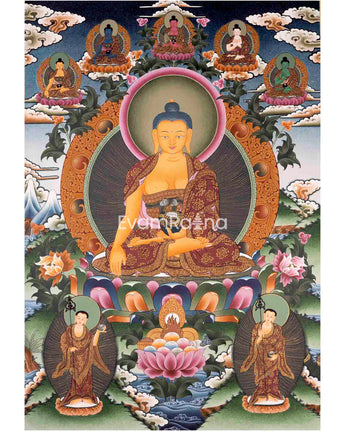
Shakyamuni Buddha Thangka | Yoga Meditation Canvas Art

100% AUTHENTIC

HANDMADE

FREE SHIPPING
Shakyamuni Buddha Thangka
Introduction To The Thangka :
Gautam Buddha, also often referred to as Shakyamuni, was a spiritual teacher upon whose lessons the foundations for Buddhism were formed. He is regarded as the Supreme Buddha and is the first enlightened individual to be visualized. Despite some confusion from those who do not follow Buddhism, it is important to note that the Buddha was not considered a God. He was rather a mere human, like the rest of us, who was able to develop an extraordinary perception about existence. This perception helped him to rid his mind of the things that cause us all a level of suffering; craving, hatred, and delusion. This, in turn, helped him to attain levels of true peace and contentment – and remain free from the suffering of sentient beings.
How does Thangka benefit us?
Every detail of a painting has a symbolic meaning. Regardless of your religious affiliation, a thangka can help you on your path to enlightenment, whether you practice Buddhism or have other religious convictions. Thangkas are paintings that depict deities with various iconographic elements and symbolism that encourage meditation on the teachings of the god they depict. Any thangka is intended to aid in removing the film of ignorance, which is a significant barrier to the road to enlightenment. The Thangka is revered as a holy item. They promote positivity, spread Buddhism's teachings, bring about peace, harmony, and oneness, and dispel any negative energy that may be there.
------------------------------------------------------------------
Size: 20"/ 51 cm (width) x 30"/ 76 cm (height)
Materials: Cotton Canvas, Acrylic Colors, Genuine 24K Gold
------------------------------------------------------------------
THIS THANGKA IS HAND-PAINTED IN THE TRADITIONAL STYLE BY NEPALI ARTIST, AND THE QUALITY IS HIGH
------------------------------------------------------------------
How to take care of your thangka?
-Hang your thangka in a traditional silk brocade
-Regular Inspection of your thangka; examine the borders and all attachments.
-Keep thangkas covered when they are on display but not in use.
-Rotate thangkas between display and storage on a regular basis, two to four times a year, to reduce the amount of exposure to light. Keep away from sunlight and humidity.
-Do not apply liquids or other materials to the surface of the thangka.
Shipping & Returns
We ship worldwide. Orders dispatch in 2–3 business days. International delivery typically arrives in 4–10 business days via DHL Express, depending on destination and carrier conditions. All items ship free globally.
Returns are accepted within 14 days of delivery. Products must be returned in original condition for a refund to be issued once received and inspected. Terms and conditions apply.











